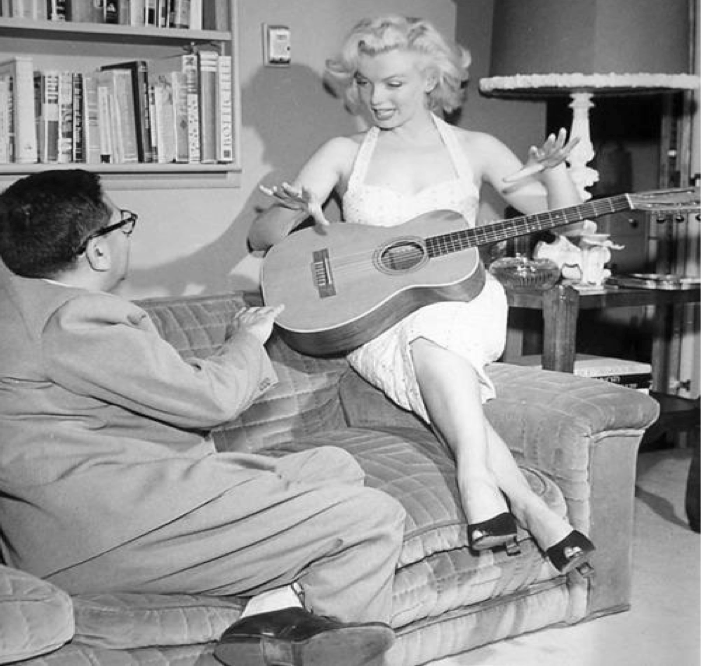
Marilyn Monroe was always on the move, calling at least 43 residences of one kind or another home during her 36 years. Each place had a valuable supporting role in the peripatetic life of Norma Jean Mortenson, especially the seven apartments where she lived within the boundaries of today’s West Hollywood.
They cover a period from Marilyn’s earliest bit parts in 1947 to breakthroughs and her marriage to Joe DiMaggio seven years later. Her ties to West Hollywood are much stronger than former addresses alone. Marilyn made only 30 movies during her career, but 17 of them were released when she lived here.
Well-known hotels and celebrity-owned cottages and bungalows afforded her much-needed privacy on occasion, but for shorter periods than rental apartments. This article focuses on permanent residences, or as permanent as they ever got for Marilyn, and the events in her life when she lived in each one.
1) 8499 Fountain Ave., #5 – El Palacio Apartments. August 1947 (5 months)
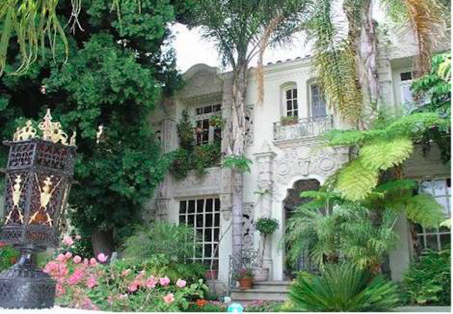
Marilyn wound up living here out of sheer ambition and determination to work hard to improve by exploiting every opportunity in sight. This was Marilyn’s first apartment in West Hollywood and 15th overall in her life.
Today the El Palacio apartment where she lived for five months in late 1947 is owned by actress Lindsay Lohan, a notorious Marilyn wanna-be who bought the unit in 2007, according to the website CurbedLA.
Her progression through the Twentieth Century Fox system seemed to be going well under a 1946 contract that paid a modest $75 a week, typical for young unknowns at the time. She took classes in dancing, singing and pantomime while posing for endless publicity photos. Like most others, she occasionally was pressed into service as an extra in several movies.
The following spring she was given her first speaking role – a bit part in a mediocre musical comedy called “Scudda Hoo! Scudda Hey!” It was a significant step up from work as an extra, but still, she got the 14th billing out of 15 actors in the film. Several months later, she landed another bit role, this one in the drama “Dangerous Years” that exploited America’s rising interest in postwar juvenile delinquency.
Despite the initial interest, Fox didn’t renew her contract when it expired a few days after her shots were completed. Even though that was typical turnover of contract players at option time among all studios, Fox showed no interest in developing Marilyn’s acting career. After all, the major star at Fox during this time was another blonde actress – Betty Grable –whose popularity as a pinup had soared during World War II.
Two weeks before her contract was set to expire in August 1947, Monroe was sent to the studio’s annual golf tournament in Rancho Park at the Cheviot Hills Country Club next to Fox’ facilities. Marilyn was among a group of young starlets picked by Fox executives to carry golf bags for movie stars like Jimmy Stewart, Henry Fonda and John Wayne.
She lucked out by being assigned to John Carroll, actor, renowned singer and husband of Lucille Ryman, Metro Goldwyn Meyer’s famous casting director. Marilyn loved these functions, especially if there were photo opportunities, an activity at which she excelled far beyond all other starlets.
Patrons of the arts, the Carrolls gave lots of moral as well as financial support to young beginners. They became friendly and soon took Marilyn under their wing.
Most of the time, the Carrolls lived at their ranch in Granada Hills, but the couple also owned an in-town apartment at El Palacio, 8491-8499 Fountain Ave. They decided to house Marilyn there, providing her with $100 a week and introducing her to their very impressive circle of friends in Los Angeles and at their Granada Hills ranch. She stayed at the El Palacio apartment for five months.
Within a year, Marilyn appeared in “The Asphalt Jungle,” written and directed by John Huston, thanks to Lucille Ryman. Huston kept his horses at the Carrolls’ ranch and owed Ryman a considerable amount for their feeding, housing and upkeep. She reportedly threatened to sell Huston’s stallions to make up his debt, unless he gave the part of Angela Phinlay in “The Asphalt Jungle” to Marilyn.
2) 1309 Harper Ave. – Romanesque Villas. Fall 1950 (5 months)
A six-month contract Marilyn signed with Columbia Pictures in March 1948 led to one of her longest and most valued personal and professional relationships. It happened when Columbia’s head drama coach, Natasha Lytess, was asked to help develop Marilyn’s acting skills.
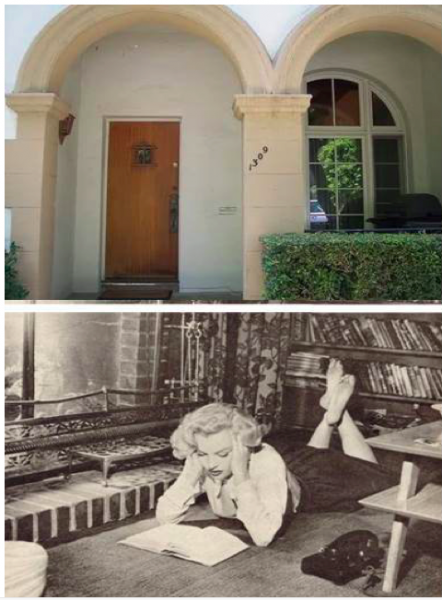
Lytess was a serious, strict woman with a demanding personality who became the first person ever to recognize that Marilyn did indeed possess true acting talent. The highly experienced coach also was impressed by the starlet’s determination to improve, and by her willingness to work hard no matter how grueling the schedule.
Marilyn shared Lytess’ two-room Harper Avenue apartment in the Romanesque Villas for five months in 1950. It was Marilyn’s second apartment in West Hollywood and 21st residence overall.
Lytess began working with Marilyn in 1948 during rehearsals for a supporting role in “Ladies of the Chorus.” She continued supporting Marilyn personally for her next 20 movies, through “The Seven Year Itch” in 1955.
Columbia’s Harry Cohn didn’t renew Marilyn’s contract when it expired later in 1948. The volatile and temperamental Cohn claimed that she had no acting talent. For her part, Marilyn made it known that Cohn had invited her to spend a weekend aboard his yacht. When she refused, he snapped at her, “This is your last chance, baby.”
Regardless of the circumstances, Cohn’s bad decision would come back to haunt him for not recognizing the star quality of Marilyn Monroe. His version of a blonde bombshell turned out to be Kim Novak.
Lytess put a lot of herself into Marilyn’s career at a time when nobody had the courage. The veteran acting coach provided stability and helped Marilyn develop her talents and to explore her curiosity about the world of theatre. Lytess even quit her job at Columbia in 1950 to coach her most famous pupil exclusively.
Since Marilyn didn’t complete high school, the drama coach helped provide an education Marilyn never received. In addition, Marilyn took literature and art history classes at UCLA while living with Lytess.
Movies released during this time in which Marilyn had a role included “The Asphalt Jungle” (directed by John Huston and starring Sterling Hayden), “All About Eve” (directed by Joseph Mankiewicz and starring Bette Davis, Anne Baxter and George Sanders), “The Fireball” (starring Mickey Rooney and Pat O’Brien) and “Right Cross” (starring June Allyson, Dick Powell and Ricardo Montalban).
Despite the promise these movies showed, the period was terribly troubling for Marilyn. Her William Morris agent, Johnny Hyde, suffered a heart attack in December while in Palm Springs. He died a few days later in a Los Angeles hospital.
Hyde was madly in love with her and wanted badly for them to marry. He had invited Marilyn to his house in Palm Springs that week but she declined. In many ways, Hyde was the protector she would spend her life looking for. With his death, she lost an ally, a friend and a father.
Marilyn is said to have blamed herself for his death and reportedly tried to commit suicide a second time. On Christmas Eve, Lytess arrived at the apartment on Harper Avenue and found a note on the door reading, “I leave my car and my mink stole to Natasha”, and a second one inside the apartment that asked Barbara, Natasha’s daughter, not to come in the bedroom. Lytess then discovered Marilyn unconscious, having taken some drugs from Schawb’s. She was transported to the hospital where she had a gastric lavage
3) 8573 Holloway Drive. November 1951 (2 months)
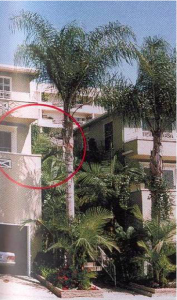
Marilyn met Shelley Winters, another young actress at a charity baseball game in the late 1940s. They soon became good friends and began sharing an apartment on Holloway Drive in November 1951. It was Marilyn’s third West Hollywood residence and 24th home in her life. Many years later, Winters recalled a particular memory about Marilyn when they were roommates.
“Marilyn (Monroe) and I lived together for a while when we were in our early 20s, and one morning I said, ‘Men have the freedom to do what they want and they’re admired. Why shouldn’t women be free?’ We were sort of advanced for our time,” according to an April 9, 1995 Los Angeles Times article.
“One Sunday, we made a list of men we wanted to sleep with, and there was no one under 50 on hers,” she adds. “I had Laurence Olivier, Errol Flynn – all the handsome actors and directors of that time. She sips some Coke, leans back on her bed and sighs. I never got to ask her before she died how much of her list she had achieved, but on her list was Albert Einstein, and after her death, I noticed that there was a silver-framed autographed picture of him on her white piano.”
4) 1121 Hilldale Ave. July 1952 (6 months)
Marilyn rented a small house at 1121 Hilldale Ave. during the second half of 1952. It was her fourth home in West Hollywood and 26th overall. She didn’t like it much, though, declaring that she “wasn’t ready for this kind of life” at a time when she had so much to do, and moved in a suite at the Bel Air Hotel.
While living at this address, she began flying to New York on weekends to be with Joe DiMaggio for his recording of the Yankees program during the baseball season. DiMaggio introduced her to his family in San Francisco in July after dating her for only four months. By the end of summer, he asked her to think about giving up the cinema for him.
In August, she flew to San Diego to attend a party organized by Fox at conductor Ray Anthony’s home for the recording of the song “Marilyn” by Ervin Drake and Jimmy Shirl. Marilyn arrived by helicopter and delighted the guests by playing percussion under Mickey Rooney’s direction.
When Marilyn lived at this West Hollywood address, “Monkey Business” (with Cary Grant) was released in September, “O’Henry’s Full House” (with Fred Allen and Anne Baxter) was released in October, “Clash by Night” (directed by Fritz Lang and starring Barbara Stanwyck, Robert Ryan and Paul Douglas), and “We’re Not Married” co-starring Ginger Rogers and Victor Moore). Shooting began for “Gentlemen Prefer Blondes” (directed by Howard Hawks and co-starring Jane Russell and Charles Coburn). On the set, Hawks was exasperated by Marilyn’s repeated lateness, her nervous fragility and her dependence toward Natasha Lytess. Marilyn had concluded the breakthrough period of her acting career at this point and was wildly popular.
5) 882 N. Doheny Dr. #3. Jan. 1953 to Jan. 1954 and again in April 1961
This Doheny Drive residence was once home to Frank Sinatra and Marilyn Monroe though not at the same time. Marilyn lived here at two separate times during the 1950s and 1960s. They constituted her 31st and 47th residences respectively in her life.
Built in 1952, Marilyn first moved here in 1953 and lived there for about a year before marrying baseball legend Joe DiMaggio on Jan. 14, 1954. They were divorced nine months later.
Marilyn lived in a three-room apartment on the second floor. Jane Russell and interior designer Thomas Lane helped her to decorate everything in white with thick carpets and a baby grand piano. Given her immense popularity, thanks to starring roles in both “Niagara” (released in 1953 co-starring Charles Brackett and Walter Reisch) and “Gentleman Prefer Blonds,” she lived very modestly in the third of five units – a one bedroom, one bathroom dwelling that measured a scant 648 square feet.
It was a tumultuous period. In March 1953, actress Joan Crawford denounced Marilyn in an Associated Press interview for the “ridiculous show” of Marilyn, reminding everyone that “the public likes provocative feminine personalities, but it also likes to know that, underneath, the actresses are ladies.” Crawford further declared, “Young people don’t like (Marilyn) … because they don’t like to see that sex is exploited. And don’t forget the women. They don’t drag their family to movie theaters if the film doesn’t fit with their husband and children.”
By the end of the year, Marilyn was fighting with Fox over many contractual issues, all with a great deal of participation (or interference as some claimed) by DiMaggio. She no doubt was one of 20th Century Fox’s biggest stars. He was seeking a more important payment as a sign of respect and gratitude, and he claimed on her behalf that she wanted to make less movies and that she wanted to be able to choose the screenplays, the directors and head cameramen of each of her movies. He also blocked Marilyn’s access to her longtime acting coach, whom he disliked. Most observers said the feeling was mutual.
In 1961, Marilyn returned to Los Angeles after six years in New York City and her divorce from DiMaggio. She lived at this same address again but in a different unit. To deter intruders, the name on her mailbox was the one of Marjorie Stengel, one of her former secretaries.
This unit was blue with mirrors from the floor to the ceiling in the dressing-room, and a black lacquered front door. Marilyn made minor changes only, bringing just a few belongings (her books, make-up and clothes) and didn’t hang any of the reproductions which made the place more familiar for her.
6) 8338 De Longpre Ave. Nov. 1954 – 1 month
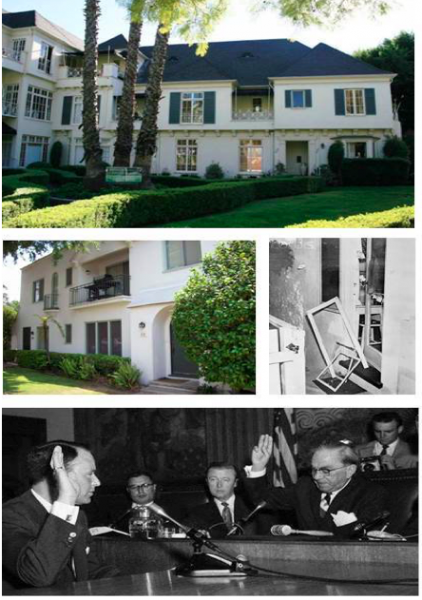
Marilyn lived slightly more than a month at the Brandon Hall Apartments following her divorce from Joe DiMaggio. It was the sixth place she lived in West Hollywood and the 34th in her life.
This is where Marilyn lived when she was innocently caught up in one of the biggest – and dumbest – scandals to ever hit Hollywood. DiMaggio hadn’t accepted the fact that Marilyn divorced him because he was physically abusive, so he and his famous actor pal Frank Sinatra cooked up a painfully misguided attempt to prove she left him for another man. It was called the Wrong Door Raid.
Acting on Sinatra’s advice, DiMaggio hired a private detective to watch Marilyn beginning in mid-October (obviously, to collect faults against her). On the night of Nov. 4, 1954, the detective informed DiMaggio that he spotted Marilyn’s car at 8122 Waring Ave., West Hollywood.
Turns out, Marilyn was visiting actress friend Sheila Stuart, who lived in one of the building’s three apartments. Stuart and Monroe were both students of singing coach Hal Shaefer, who lived in another of the trio of apartments.
DiMaggio and Sinatra happened to be together at a Hollywood restaurant when the call came. The information reportedly sent DiMaggio into a rage, and within an hour, he had assembled a small group at the corner of Waring and Kilkea Avenue. They planned to bust into the apartment Marilyn was in and catch her in a naked and compromising situation.
The only problem was that they didn’t know which of the three apartments she was in, so they picked one and essentially staged a home invasion hoping they chose correctly. They didn’t. Instead, they went in with powerful camera spotlights turned on, breaking dishes, doors and furniture, awakening and scaring the daylights out of the occupant, a 37-year-old woman named Florence Kotz at 11:30 p.m.
They hadn’t managed to locate Sheila Stuart’s apartment which was a bit further away. The commotion alerted Sheila and Marilyn, who took advantage of the mêlée to clear off.
This story lived on as the “raid on the wrong door”. Florence Kotz brought a lawsuit against Sinatra and DiMaggio, asking for $200 000 in damages. Sinatra denied any involvement in the commando action, and four years later, the case was closed by the California Supreme Court, after Sinatra’s lawyer found an amicable arrangement whereby Sinatra paid Kotz $7,500.
In 1957 the Senate of the State of California decided to have a close look at the activities of some private detectives and made several of those involved appear before it. They included the detective involved as well as Sinatra, who denied having been involved with the breaking and entering.
Despite months of important tension and a divorce, Joe and Marilyn kept on meeting, sparking much media speculation about the two of them reuniting, oddly enough.
Fascinating and thorough accounts of the Wrong Door Raid can be found at Playground of the Stars (http://www.playgroundtothestars.com/2010/12/wrong-door-raid/) as well as a groundbreaking book by Henry E. Scott, “Shocking True Story: Confidential Magazine.” (http://www.nytimes.com/2010/01/25/books/25book.html?_r=0)
When Marilyn moved out, it was the fourth time she changed addresses in 1954 – and there were two more to come before year-end.
7) Voltaire (Granville) Apts. 1424 N. Crescent Heights – 1954
After leaving DiMaggio, Monroe stayed in an apartment at the Voltaire (currently known as the Granville Towers) before moving back to New York City. It was her seventh and last home in West Hollywood and her 35th overall.
After her divorce from DiMaggio, and before going to New York, she stayed at Anna Kargers, on Sunset Boulevard. Two movies in which she starred were released during this time, “River of No Return” and “There’s No Business Like Show Business.”

Marilyn Monroe is my all time favorite. Even though I don’t have a body like here and I do not want a tragic end like her. I have never known what she called home. Thanks!
Marilyn Monroe is my all time favorite. Even though I don’t have a body like here and I do not want a tragic end like her. I have never known what she called home. Thanks!
Fascinating read! Marilyn Monroe’s connection to West Hollywood is truly iconic. Her presence in various homes in the area adds an extra layer of allure to this vibrant neighborhood’s history. It’s like taking a step back in time and walking in the footsteps of a Hollywood legend. Thanks for sharing!
It’s perfect time to make a few plans for the long run and it is time to be happy. I’ve learn this publish and if I may I desire to recommend you some interesting things or advice.
I am a huge fan of Marilyn Monroe. She was amazingly beautiful and her controversies are still making people talk. Awesome information!
Someone necessarily assist to make critically articles I would state. This is the very first time I frequented your website page and thus far? I amazed with the analysis you made to create this particular put up incredible. Great process
Very interesting. One item has me wondering: You write that Marilyn attended a 1952 party at Ray Anthony’s home in San Diego. Several sites, including one called “MyMarilyn,” report that Anthony’s home was in Sherman Oaks, not San Diego, and this is where the party for Marilyn took place.
Here’s a quote by Marilyn Monroe:
“No one ever told me I was pretty when I was a little girl. All little girls should
be told they’re pretty, even if they aren’t.” – Marilyn Monroe Quotes
More Here: http://iambored.pro/marilyn-monroe-quotes/
Wonderful article. I’ve been a fan of MM since I was a child & am probably a walking volume of information on her life. I visited & was shown around her last home in Westwood in the early 1970s, own probably every book ever written about her, & even once owned a pair of her shoes. Every year I attend the MM memorial service at Westwood Park. Most of the people who were part of her life who joined us there are also gone now, but it’s amazing to see how many young people are dedicated fans & how the… Read more »